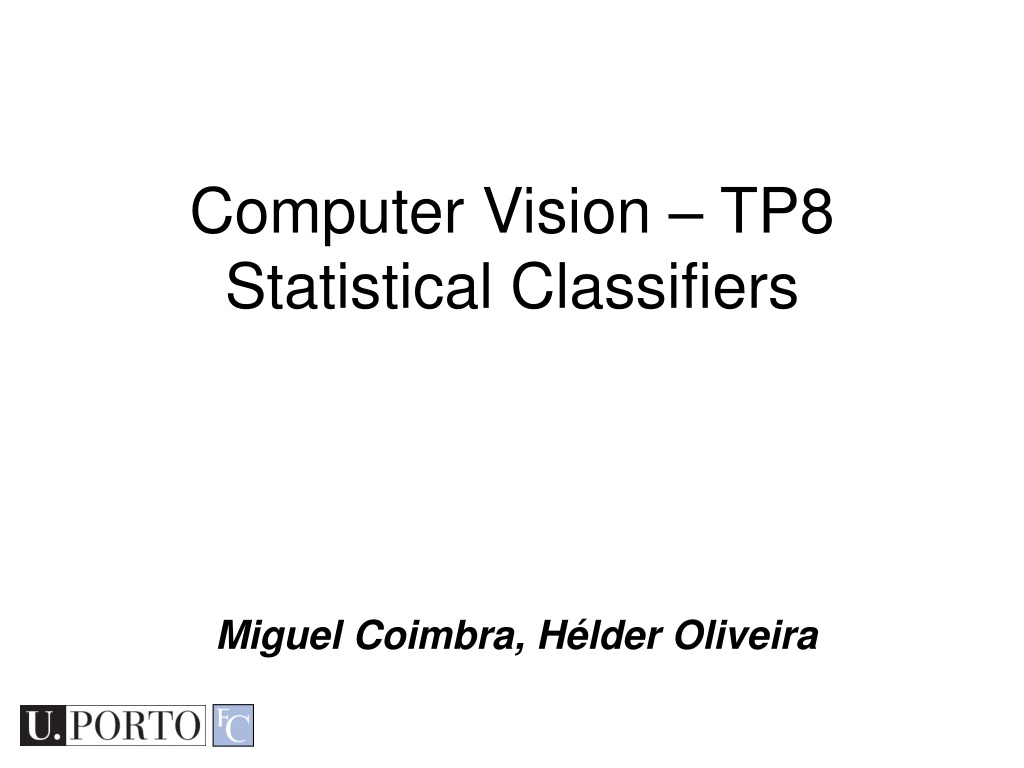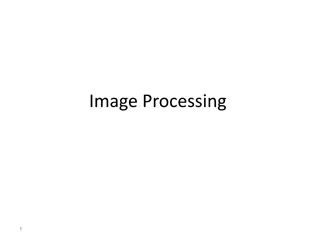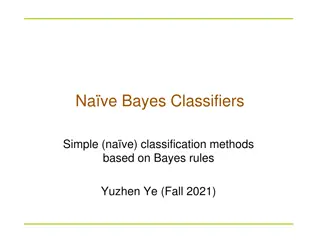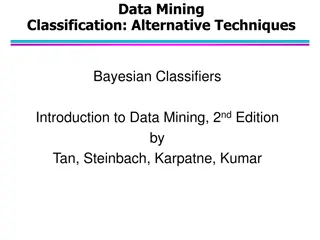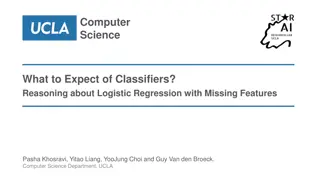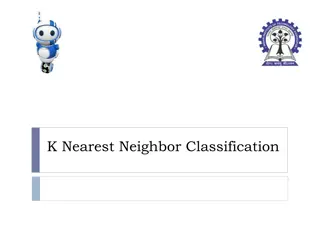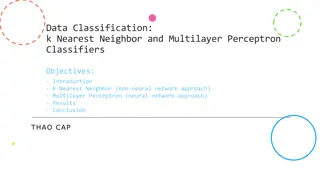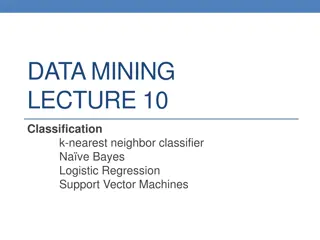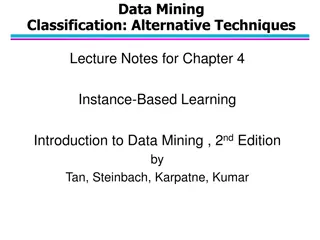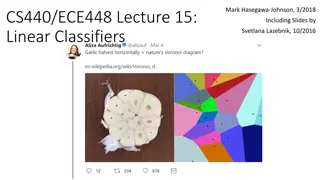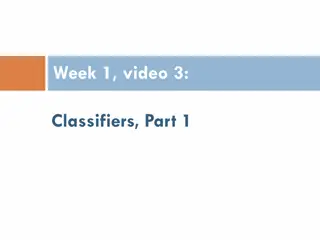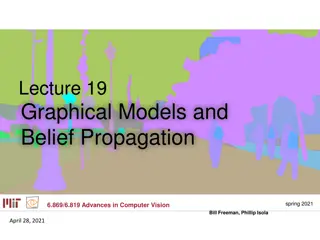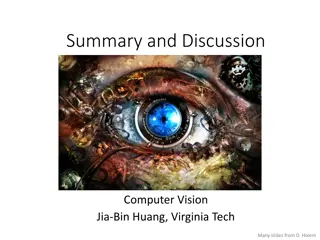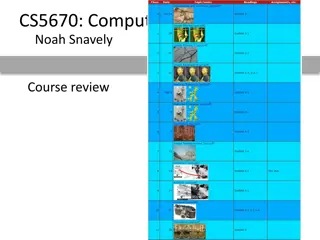Understanding Statistical Classifiers in Computer Vision
Exploring statistical classifiers such as Support Vector Machines and Neural Networks in the context of computer vision. Topics covered include decision-making using statistics, feature naming conventions, classifier types, distance measures, and more.
Download Presentation

Please find below an Image/Link to download the presentation.
The content on the website is provided AS IS for your information and personal use only. It may not be sold, licensed, or shared on other websites without obtaining consent from the author. Download presentation by click this link. If you encounter any issues during the download, it is possible that the publisher has removed the file from their server.
E N D
Presentation Transcript
Computer Vision TP8 Statistical Classifiers Miguel Coimbra, H lder Oliveira
Outline Statistical Classifiers Support Vector Machines Neural Networks Computer Vision TP8 - Statistical Classifiers 2
Topic: Statistical Classifiers Statistical Classifiers Support Vector Machines Neural Networks Computer Vision TP8 - Statistical Classifiers 3
Statistical PR I use statistics to make a decision I can make decisions even when I don t have full a priori knowledge of the whole process I can make mistakes How did I recognize this pattern? I learn from previous observations where I know the classification result I classify a new observation Computer Vision TP8 - Statistical Classifiers 4
Features Feature Fi Naming conventions: Elements of a feature vector are called coefficients Features may have one or more coefficients Feature vectors may have one or more features f F = i i Feature Fiwith N values. i i f F , 1 = ,..., f f 2 i iN Feature vector F with M features. F F F | 2 1 = | ... | F M Computer Vision TP8 - Statistical Classifiers 5
Classifiers A Classifier C maps a class into the feature space , true y K = ( , ) C x y Spain , false otherwise Various types of classifiers Nearest-Neighbours Support Vector Machines Neural Networks Etc... Computer Vision TP8 - Statistical Classifiers 6
Distance to Mean I can represent a class by its mean feature vector C = Feature Space 35 30 Spain Euclidean Distance F 25 To classify a new object, I choose the class with the closest mean feature vector Different distance measures! 20 Y Coordinate 15 10 Portugal 5 0 Porto -10 0 10 20 30 -5 -10 X Coordinate Computer Vision TP8 - Statistical Classifiers 7
Possible Distance Measures L1 Distance ? ?1 ?,? = ?? ?? L1 or Taxicab Distance ?=1 Euclidean Distance (L2 Distance) ? 2 ?2 ?,? = ?? ?? ?=1 Computer Vision TP8 - Statistical Classifiers 8
Gaussian Distribution Defined by two parameters: Mean: Variance: 2 Great approximation to the distribution of many phenomena. Central Limit Theorem 2 1 ( ) x u = ( ) exp f x 2 2 2 Computer Vision TP8 - Statistical Classifiers 9
Multivariate Distribution For N dimensions: Mean feature vector: Covariance Matrix: = F Computer Vision TP8 - Statistical Classifiers 10
Mahalanobis Distance Based on the covariance of coefficients Superior to the Euclidean distance Computer Vision TP8 - Statistical Classifiers 11
Generalization Classifiers are optimized to reduce training errors (supervised learning): we have access to a set of training data for which we know the correct class/answer What if test data is different from training data? Computer Vision TP8 - Statistical Classifiers 12
Underfitting and Overfitting Is the model too simple for the data? Underfitting: cannot capture data behavior Is the model too complex for the data? Overfitting: fit perfectly training data, but will not generalize well on unseen data Computer Vision TP8 - Statistical Classifiers 13
Bias and variance Bias Average error in predicting correct value Variance Variability of model prediction High bias High variance Low bias, low variance Computer Vision TP8 - Statistical Classifiers 14
Bias-variance tradeoff total err = bias2 + variance + irreducible err Computer Vision TP8 - Statistical Classifiers 15
K-Nearest Neighbours Algorithm Choose the closest K neighbours to a new observation Classify the new object based on the class of these K objects Characteristics Assumes no model Does not scale very well... Computer Vision TP8 - Statistical Classifiers 16
Topic: Support Vector Machines Statistical Classifiers Support Vector Machines Neural Networks Computer Vision TP8 - Statistical Classifiers 17
Maximum-margin hyperplane There are many planes that can separate our classes in feature space Only one maximizes the separation margin Of course that classes need to be separable in the first place... M , 1 + } 1 ( : ) x { f , 1 + } 1 { C = M { , ,..., }, V v v v v 1 2 M i Computer Vision TP8 - Statistical Classifiers 18
Support vectors The maximum- margin hyperplane is limited by some vectors These are called support vectors Other vectors are irrelevant for my decision Computer Vision TP8 - Statistical Classifiers 19
Decision I map a new observation into my feature space Decision hyperplane: = + w b x w , 0 ) . ( N, b Decision function: = + ( ) (( . ) ) f x sign w x b A vector is either above or below the hyperplane Computer Vision TP8 - Statistical Classifiers 20
Slack variables Most feature spaces cannot be segmented so easily by a hyperplane Solution: Use slack variables Wrong points pull the margin in their direction Classification errors! Computer Vision TP8 - Statistical Classifiers 21
But this doesnt work in most situations... Still, how do I find a Maximum-margin hyperplane for some situations? Most real situations face this problem... Computer Vision TP8 - Statistical Classifiers 22
Solution: Send it to hyperspace! Take the previous case: f(x) = x Create a new higher- dimensional function: g(x) = (x, x2) A kernel function is responsible for this transformation https://www.youtube.com/watch?v=3liCbRZPrZA Computer Vision TP8 - Statistical Classifiers 23
Typical kernel functions Linear = + ( , ) . 1 K x y x y Polynomial = ) 1 + p ( , ) ( . K x y x y Radial-Base Functions 2 2 / 2 x y = ( , ) K x y e Sigmoid = ( , ) tanh( . ) K x y kx y Computer Vision TP8 - Statistical Classifiers 24
Classification Training stage: Obtain kernel parameters Obtain maximum-margin hyperplane Given a new observation: Transform it using the kernel Compare it to the hyperspace Computer Vision TP8 - Statistical Classifiers 25
Topic: Neural Networks Statistical Classifiers Support Vector Machines Neural Networks Computer Vision TP8 - Statistical Classifiers 26
If you cant beat it.... Copy it! Computer Vision TP8 - Statistical Classifiers 27 http://managementcraft.typepad.com/photos/uncategorized/brain.jpg
Biological Neural Networks Neuroscience: Population of physically inter- connected neurons Includes: Biological Neurons Connecting Synapses The human brain: 100 billion neurons 100 trillion synapses Computer Vision TP8 - Statistical Classifiers 28
Biological Neuron Neurons: Have K inputs (dendrites) Have 1 output (axon) If the sum of the input signals surpasses a threshold, sends an action potential to the axon Synapses Transmit electrical signals between neurons Computer Vision TP8 - Statistical Classifiers 29
Artificial Neuron Also called the McCulloch-Pitts neuron Passes a weighted sum of inputs, to an activation function, which produces an output value McCulloch, W. and Pitts, W. (1943). A logical calculus of the ideas immanent in nervous activity. Bulletin of Mathematical Biophysics, 7:115 - 133. Computer Vision TP8 - Statistical Classifiers 30
Sample activation functions Rectified Linear Unit (ReLU) Sigmoid function 1 =1 y + u e Computer Vision TP8 - Statistical Classifiers 31
Artificial Neural Network Commonly refered as Neural Network Basic principles: One neuron can perform a simple decision Many connected neurons can make more complex decisions Computer Vision TP8 - Statistical Classifiers 32
Characteristics of a NN Network configuration How are the neurons inter-connected? We typically use layers of neurons (input, output, hidden) Individual Neuron parameters Weights associated with inputs Activation function Decision thresholds How do we find these values? Computer Vision TP8 - Statistical Classifiers 33
Learning paradigms We can define the network configuration How do we define neuron weightsand decision thresholds? Learning step We train the NN to classify what we want Different learning paradigms Supervised learning Unsupervised learning Reinforcement learning Appropriate for Pattern Recognition. Computer Vision TP8 - Statistical Classifiers 34
Learning We want to obtain an optimal solution given a set of observations A cost function measures how close our solution is to the optimal solution Objective of our learning step: Minimize the cost function Backpropagation Algorithm Computer Vision TP8 - Statistical Classifiers 35
In formulas Network output: input label Training set: Optimization: find such that It is solved with (variants of) the gradient descent, where gradients are computed via the backpropagation algorithm DMI 19/20 - Deep Learning
Losses They quantify the distance between the output of the network and the true label, i.e., the correct answer Classification problems: The output (obtained usually with softmax) is a probability distribution Loss-function: cross-entropy. It is defined in terms of the Kullback-Leibler distance between probability distributions Regression problems: The output is a scalar or a vector of continuous values (real or complex) Loss-function: mean-squared error. It is the distance associated with the L2-norm DMI 19/20 - Deep Learning
Feedforward neural network Simplest type of NN Has no cycles Input layer Need as many neurons as coefficients of my feature vector Hidden layers Output layer Classification results Computer Vision TP8 - Statistical Classifiers 38
Resources Andrew Moore, Statistical Data Mining Tutorials , http://www.cs.cmu.edu/~awm/tutorials.htm l C.J. Burges, A tutorial on support vector machines for pattern recognition , in Knowledge Discovery Data Mining, vol.2, no.2, 1998, pp.1-43. Computer Vision TP8 - Statistical Classifiers 39
